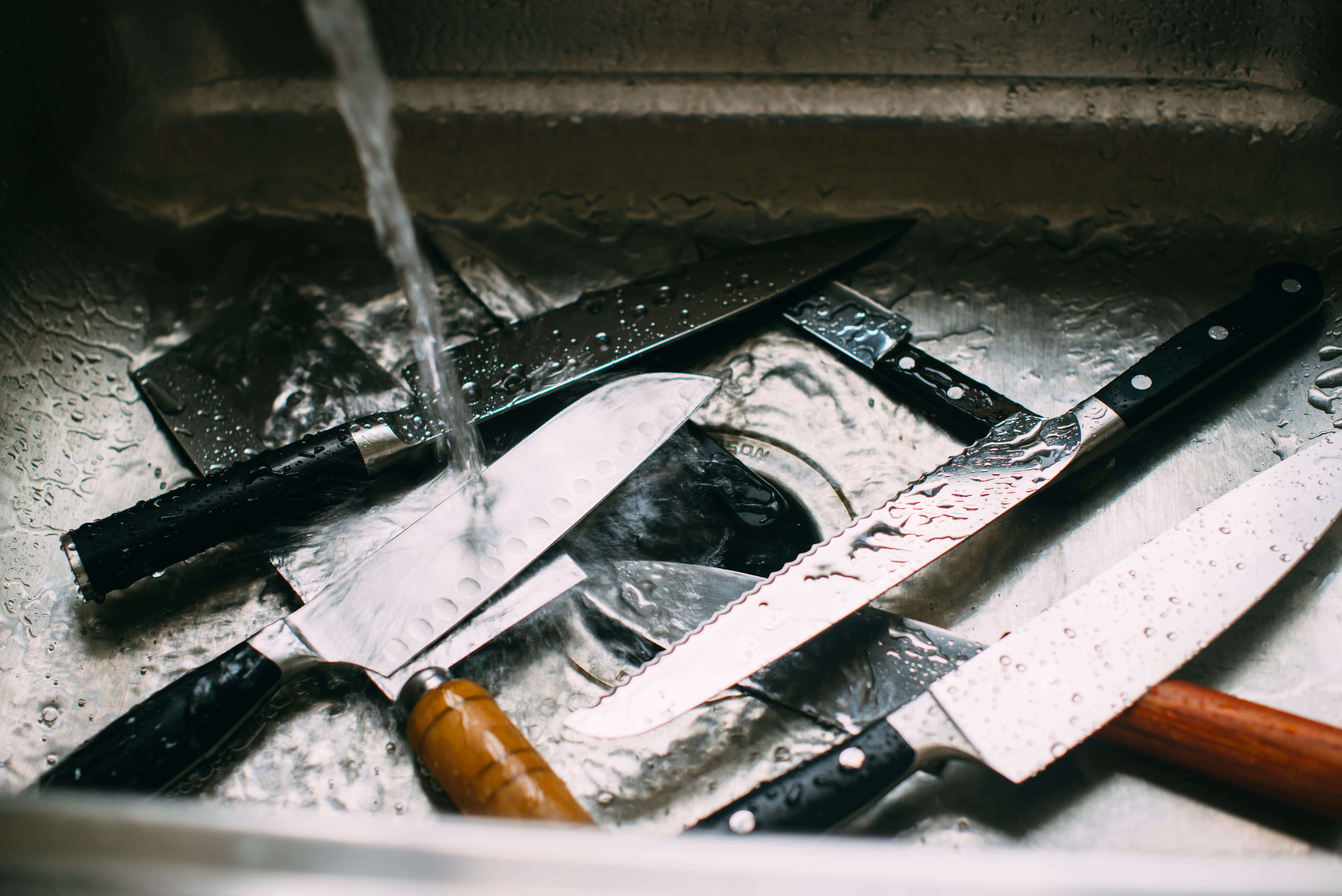Imagine trying to slice through a ripe tomato with a dull, dirty knife. Frustrating, right?
Your knives are more than just kitchen tools; they’re an essential part of your culinary experience. Keeping them clean and well-stored is crucial for both your safety and the longevity of the knives. But how exactly should you do it?
This article will guide you through simple, effective methods to ensure your knives remain sharp, safe, and ready for action. Discover the secrets to maintaining your knives like a professional chef, and transform your cooking experience. Don’t let dull blades and improper storage hold you back. Dive into the article and unlock the potential of your kitchen knives.
Choosing The Right Cleaning Tools
Keeping your knives clean is essential for their longevity and performance. Choosing the right cleaning tools is crucial to prevent damage and maintain their sharpness. Have you ever wondered if you are using the correct supplies to clean your knives?
Essential Cleaning Supplies
When it comes to cleaning your knives, simplicity is key. Warm water and mild dish soap should be your go-to. They’re gentle yet effective. Your knives don’t need harsh chemicals that can corrode the metal.
A soft sponge is another must-have. It allows you to clean your knives without scratching the surface. Think of it as giving your knives a gentle massage that preserves their edge.
Drying your knives immediately with a microfiber cloth is essential. This prevents water spots and rust. Have you ever left a knife wet and found it with rust spots the next day? A quick dry can avoid that.
Avoiding Damaging Materials
Steer clear of abrasive materials like steel wool or rough scrub pads. They can scratch and damage the blade. Have you ever seen a knife with unsightly scratches? These materials are often the culprit.
Bleach is another no-go. It can discolor and weaken the blade. What might seem like a thorough clean can actually be a recipe for disaster.
Dishwashers are not a safe haven for knives. The high heat and harsh detergents can ruin the handle and blade. Do you really want to risk your knives getting chipped or dulled? Hand washing is always safer.
Choosing the right cleaning tools ensures your knives remain in pristine condition. What changes will you make to your cleaning routine to extend your knives’ lifespan?

Credit: www.thekitchn.com
Proper Knife Cleaning Techniques
Clean knives with warm, soapy water immediately after use to prevent rust. Dry thoroughly before storage. Store knives in a wooden block or magnetic strip to keep them safe and sharp.
Proper knife cleaning techniques ensure your knives last longer. Clean knives prevent the spread of bacteria and maintain sharpness. Knowing how to clean them properly is crucial. Let’s explore the best methods to clean your knives.
Washing By Hand
Hand washing is gentle on your knives. Use a mild dish soap and warm water. Scrub the blade carefully with a soft sponge. Avoid using abrasive pads to prevent scratches. Rinse the knife under running water after scrubbing. This removes soap residue and food particles.
Cleaning In A Dishwasher: Pros And Cons
Dishwashers offer convenience. But they can damage knives. The heat and strong detergents dull the blade. Knives may also bump against other utensils, causing nicks. If you must use a dishwasher, place the knife securely. Choose a gentle cycle and avoid high heat.
Drying Your Knives Correctly
Drying knives immediately prevents rust. Use a clean, dry cloth to wipe the blade. Avoid air drying, which may leave water spots. Store knives only when completely dry. Proper drying extends your knife’s lifespan.
Safe Storage Options
Clean knives with warm, soapy water and dry them immediately. Store them in a knife block or magnetic strip to prevent damage. Safe storage ensures longevity and maintains sharpness.
Cleaning and storing knives properly extends their lifespan. Proper storage maintains sharpness and ensures safety. Various storage solutions cater to different needs and preferences. Choosing the right storage can prevent accidents and prolong knife integrity. Let’s explore some popular and effective knife storage options.
Magnetic Strips Vs. Knife Blocks
Magnetic strips offer a modern touch. They save counter space and display knives attractively. Knives are easy to access and put away. Use caution to avoid accidents during use. Knife blocks provide a traditional storage option. They keep blades hidden, reducing exposure to air. Blocks come in many styles and materials. Choose one with a comfortable fit for your knives.
Drawer Inserts For Knives
Drawer inserts keep knives organized and out of sight. They prevent knives from sliding around. Inserts protect blades and keep edges sharp. Some inserts adjust to fit different knife sizes. They utilize drawer space efficiently. Ensure your drawer can accommodate the insert’s dimensions.
Protective Sheaths And Guards
Sheaths and guards provide portable protection. They cover individual blades and prevent nicks. Ideal for those with limited storage space. Sheaths are great for traveling chefs. They come in various sizes to match different knives. Select a snug fit for optimal protection.
:max_bytes(150000):strip_icc()/Simply-Recipes-Dishwasher-LEAD-01-3bb23663efcc4964876bf37075f49822.jpg)
Credit: www.simplyrecipes.com
Maintaining Knife Sharpness
Keeping your knives sharp is crucial for efficiency in the kitchen. Dull knives can cause accidents and make cooking a chore. Proper maintenance ensures they last longer and perform better.
Sharp knives make cutting easier and more precise. Regular care and attention can preserve their edge. Let’s explore how you can maintain your knife’s sharpness.
Regular Honing Techniques
Honing realigns the blade’s edge without removing material. It’s best done with a honing steel. Hold the steel vertically and gently glide the knife blade at a 15-degree angle. Maintain even pressure as you move the blade from heel to tip. Repeat this for each side several times.
Honing keeps the blade ready for daily use. It should be part of your regular kitchen routine. Done correctly, it prolongs the time between sharpenings.
When To Sharpen Your Knives
Sharpening involves grinding the blade to restore its edge. It’s necessary when honing no longer improves the sharpness. You’ll notice the knife struggling to cut smoothly. Dull blades require more force and pressure.
Sharpen your knives every few months or as needed. Professional sharpening services ensure precision. You can also use a sharpening stone or electric sharpener at home. Always follow instructions for the best results.
Preventing Rust And Corrosion
Keeping your knives in peak condition is essential for both safety and efficiency in the kitchen. Rust and corrosion are the silent enemies that can dull your blades and make them unsafe. Thankfully, preventing these nuisances is simple with a few practical strategies. Whether you’re a culinary novice or a seasoned chef, understanding how to protect your knives from rust and corrosion will ensure your tools stay sharp and reliable.
Using Oil For Protection
One effective method to shield your knives from rust is using oil. A thin layer of mineral oil can create a protective barrier on the blade, preventing moisture from causing damage. After cleaning your knife, apply a small amount of oil using a clean cloth. This simple habit can extend the life of your knives.
Think of oil as your knife’s raincoat. It repels water and keeps the steel intact. If you’ve ever found a rusty blade in the drawer, you’ll appreciate how a few minutes of oiling can save hours of scrubbing later. What type of oil should you use? Mineral oil is a popular choice, but some prefer natural oils like coconut or camellia.
Avoiding Moisture Build-up
Moisture is a major contributor to rust. To avoid it, always dry your knives thoroughly after washing. A simple swipe with a dry cloth can prevent water spots and corrosion. Remember, leaving your knives wet is an invitation for rust.
Think about where you store your knives. Is it a damp drawer or a humid kitchen corner? Consider moving them to a drier location. A knife block or magnetic strip on a wall can reduce moisture exposure. The goal is to keep them dry and rust-free, so they’re always ready for your next culinary adventure.
By taking these steps, you can ensure your knives remain in top condition, ready to slice and dice without a hitch. What challenges have you faced with knife maintenance? Share your experiences and tips, and let’s make kitchen safety a priority together.
Expert Tips For Longevity
Taking care of your knives extends their lifespan and maintains their efficiency. Proper cleaning and storage are key. This guide offers expert tips to ensure your knives last longer.
Common Mistakes To Avoid
Many people wash knives in dishwashers. This damages the blade and handle. Knives should be hand-washed with warm water and mild soap. Avoid harsh scrubbers that scratch the surface. Dry knives immediately to prevent rust.
Storing knives in a drawer without protection causes dullness. Use a knife block or magnetic strip. These options prevent accidental blade contact. This keeps them sharp and ready for use.
Regular Maintenance Schedule
Sharpen knives every few months. A sharpening stone or steel works best. This helps maintain a sharp edge. Regular honing aligns the blade’s edge. Do this weekly for optimal performance.
Oil the blade occasionally. Use food-safe mineral oil. This prevents rust and keeps the blade smooth. Check handles regularly for cracks or loose parts. Tighten screws and fix damages promptly.
Follow these simple steps for knife care. Your knives will remain sharp and reliable for years.
Frequently Asked Questions
How Should You Clean And Store Your Knife?
Clean your knife with warm water and mild soap. Dry it immediately with a soft cloth. Store it in a knife block or magnetic strip to prevent damage. Avoid putting knives in a dishwasher to maintain sharpness. Regularly sharpen your knife for best performance.
What Is The Most Hygienic Way To Store Knives?
Store knives in a knife block, magnetic strip, or drawer insert. Ensure they are clean and dry before storing. Keep blades separated to prevent damage and contamination. Regularly sanitize storage areas to maintain hygiene. Proper storage prolongs knife life and ensures safety.
What Is The Best Way To Store Knives When Not In Use?
Store knives in a wooden block or on a magnetic strip. Ensure blades face upwards for safety. Always keep them dry and clean before storage. Avoid storing them loose in drawers to prevent damage and accidents. Proper storage maintains sharpness and longevity.
Should Knives Be Stored Blade Up Or Down?
Store knives with the blade down to ensure safety. Blade-down storage reduces the risk of accidents. It also prevents the blade from dulling. Always keep knives in a designated block or holder for optimal organization and protection.
Final Words
Proper knife care keeps your blades sharp and safe. Clean them with warm water after each use. Dry thoroughly to prevent rust. Store knives in a block or magnetic strip. Avoid drawers to protect edges. Regular maintenance extends lifespan. Sharpen them periodically for best performance.
Handle with care for safety. Good habits ensure lasting quality. Invest time in upkeep for reliable kitchen tools. Remember, well-maintained knives make cooking easier. Keep them ready for your culinary adventures. Happy cooking!

Leave a Reply